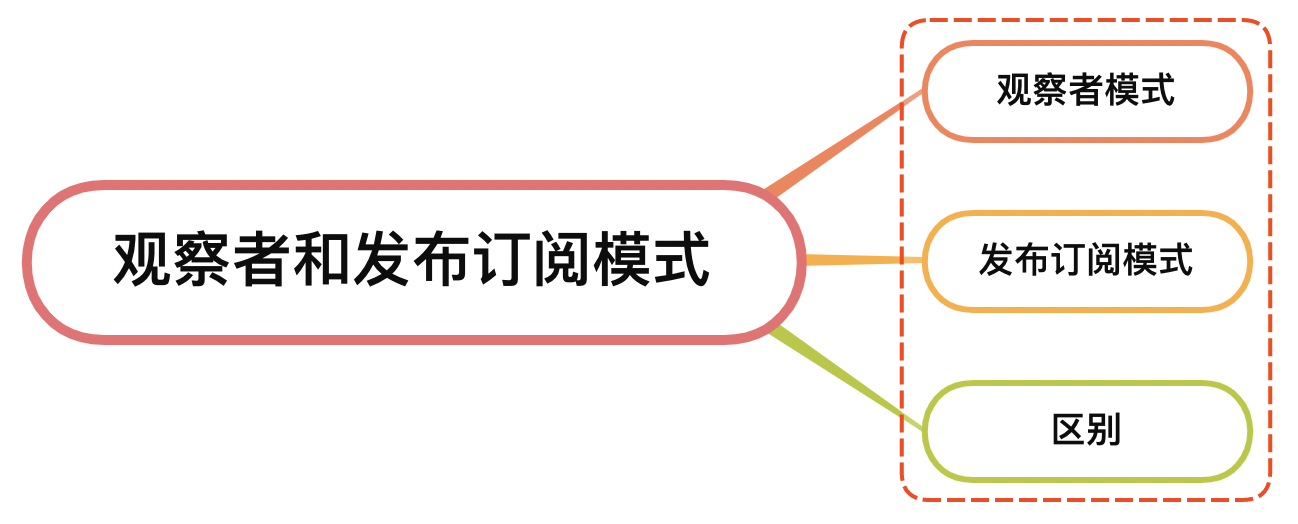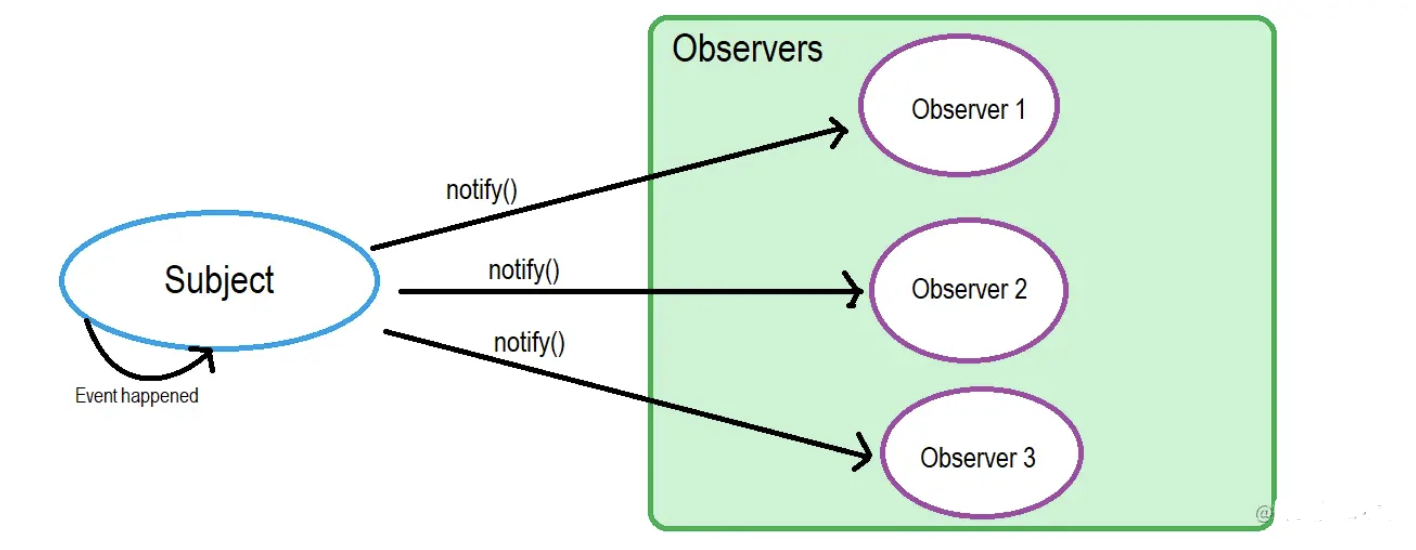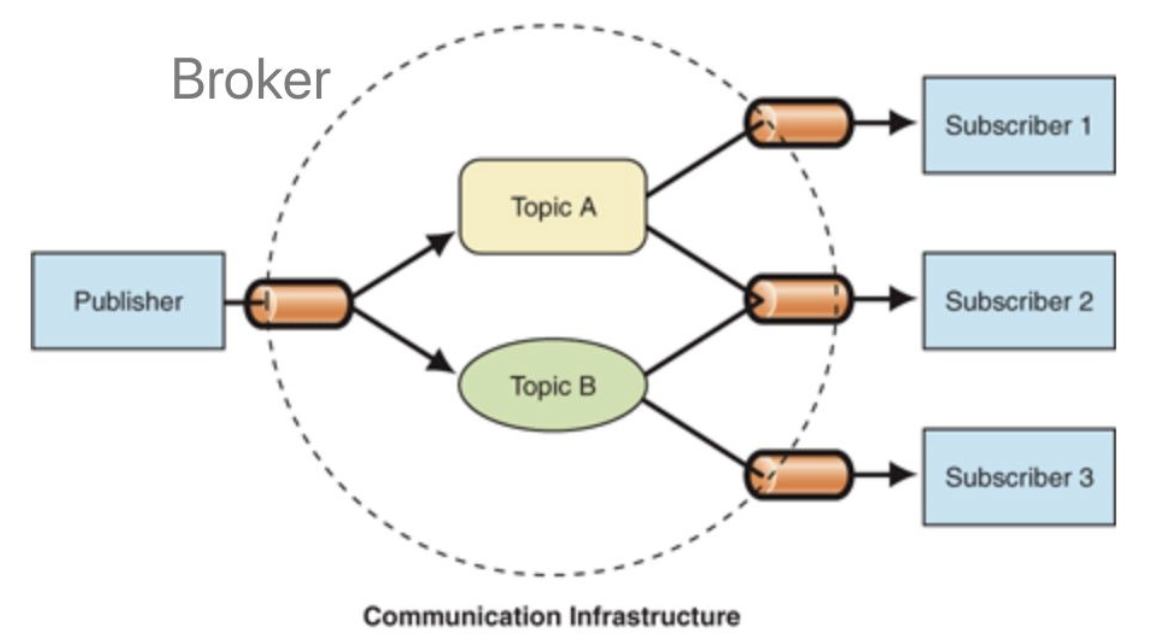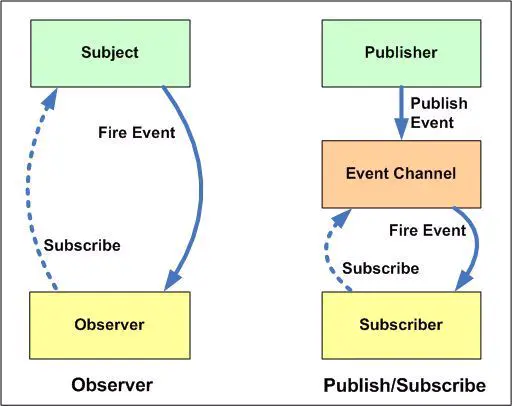面试官:说说你对发布订阅、观察者模式的理解?区别?

一、观察者模式
观察者模式定义了对象间的一种一对多的依赖关系,当一个对象的状态发生改变时,所有依赖于它的对象都将得到通知,并自动更新
观察者模式属于行为型模式,行为型模式关注的是对象之间的通讯,观察者模式就是观察者和被观察者之间的通讯

例如生活中,我们可以用报纸期刊的订阅来形象的说明,当你订阅了一份报纸,每天都会有一份最新的报纸送到你手上,有多少人订阅报纸,报社就会发多少份报纸
报社和订报纸的客户就形成了一对多的依赖关系
实现代码如下:
被观察者模式
1
2
3
4
5
6
7
8
9
10
11
12
13
14
15
16
17
18
19
20
21
| class Subject {
constructor() {
this.observerList = [];
}
addObserver(observer) {
this.observerList.push(observer);
}
removeObserver(observer) {
const index = this.observerList.findIndex(o => o.name === observer.name);
this.observerList.splice(index, 1);
}
notifyObservers(message) {
const observers = this.observeList;
observers.forEach(observer => observer.notified(message));
}
}
|
观察者:
1
2
3
4
5
6
7
8
9
10
11
12
13
| class Observer {
constructor(name, subject) {
this.name = name;
if (subject) {
subject.addObserver(this);
}
}
notified(message) {
console.log(this.name, 'got message', message);
}
}
|
使用代码如下:
1
2
3
4
5
6
7
| const subject = new Subject();
const observerA = new Observer('observerA', subject);
const observerB = new Observer('observerB');
subject.addObserver(observerB);
subject.notifyObservers('Hello from subject');
subject.removeObserver(observerA);
subject.notifyObservers('Hello again');
|
上述代码中,观察者主动申请加入被观察者的列表,被观察者主动将观察者加入列表
二、发布订阅模式
发布-订阅是一种消息范式,消息的发送者(称为发布者)不会将消息直接发送给特定的接收者(称为订阅者)。而是将发布的消息分为不同的类别,无需了解哪些订阅者(如果有的话)可能存在
同样的,订阅者可以表达对一个或多个类别的兴趣,只接收感兴趣的消息,无需了解哪些发布者存在

实现代码如下:
1
2
3
4
5
6
7
8
9
10
11
12
13
14
15
16
17
18
19
20
21
22
23
24
25
26
27
28
| class PubSub {
constructor() {
this.messages = {};
this.listeners = {};
}
publish(type, content) {
const existContent = this.messages[type];
if (!existContent) {
this.messages[type] = [];
}
this.messages[type].push(content);
}
subscribe(type, cb) {
const existListener = this.listeners[type];
if (!existListener) {
this.listeners[type] = [];
}
this.listeners[type].push(cb);
}
notify(type) {
const messages = this.messages[type];
const subscribers = this.listeners[type] || [];
subscribers.forEach((cb, index) => cb(messages[index]));
}
}
|
发布者代码如下:
1
2
3
4
5
6
7
8
9
| class Publisher {
constructor(name, context) {
this.name = name;
this.context = context;
}
publish(type, content) {
this.context.publish(type, content);
}
}
|
订阅者代码如下:
1
2
3
4
5
6
7
8
9
| class Subscriber {
constructor(name, context) {
this.name = name;
this.context = context;
}
subscribe(type, cb) {
this.context.subscribe(type, cb);
}
}
|
使用代码如下:
1
2
3
4
5
6
7
8
9
10
11
12
13
14
15
16
17
18
19
20
21
22
23
24
25
26
27
28
29
30
| const TYPE_A = 'music';
const TYPE_B = 'movie';
const TYPE_C = 'novel';
const pubsub = new PubSub();
const publisherA = new Publisher('publisherA', pubsub);
publisherA.publish(TYPE_A, 'we are young');
publisherA.publish(TYPE_B, 'the silicon valley');
const publisherB = new Publisher('publisherB', pubsub);
publisherB.publish(TYPE_A, 'stronger');
const publisherC = new Publisher('publisherC', pubsub);
publisherC.publish(TYPE_C, 'a brief history of time');
const subscriberA = new Subscriber('subscriberA', pubsub);
subscriberA.subscribe(TYPE_A, res => {
console.log('subscriberA received', res)
});
const subscriberB = new Subscriber('subscriberB', pubsub);
subscriberB.subscribe(TYPE_C, res => {
console.log('subscriberB received', res)
});
const subscriberC = new Subscriber('subscriberC', pubsub);
subscriberC.subscribe(TYPE_B, res => {
console.log('subscriberC received', res)
});
pubsub.notify(TYPE_A);
pubsub.notify(TYPE_B);
pubsub.notify(TYPE_C);
|
上述代码,发布者和订阅者需要通过发布订阅中心进行关联,发布者的发布动作和订阅者的订阅动作相互独立,无需关注对方,消息派发由发布订阅中心负责
三、区别
两种设计模式思路是一样的,举个生活例子:
- 观察者模式:某公司给自己员工发月饼发粽子,是由公司的行政部门发送的,这件事不适合交给第三方,原因是“公司”和“员工”是一个整体
- 发布-订阅模式:某公司要给其他人发各种快递,因为“公司”和“其他人”是独立的,其唯一的桥梁是“快递”,所以这件事适合交给第三方快递公司解决
上述过程中,如果公司自己去管理快递的配送,那公司就会变成一个快递公司,业务繁杂难以管理,影响公司自身的主营业务,因此使用何种模式需要考虑什么情况两者是需要耦合的
两者区别如下图:

在观察者模式中,观察者是知道Subject的,Subject一直保持对观察者进行记录。然而,在发布订阅模式中,发布者和订阅者不知道对方的存在。它们只有通过消息代理进行通信。
在发布订阅模式中,组件是松散耦合的,正好和观察者模式相反。
观察者模式大多数时候是同步的,比如当事件触发,Subject就会去调用观察者的方法。而发布-订阅模式大多数时候是异步的(使用消息队列)
参考文献




